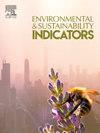城乡一体化与弹性时空动态:成渝城市群多层次网络研究
IF 5.6
Q1 ENVIRONMENTAL SCIENCES
引用次数: 0
摘要
在新型城镇化和城乡一体化加快推进的背景下,厘清城乡一体化与区域韧性的多维互动关系,对于实现区域协调发展至关重要。研究了2009 - 2022年成渝城市群城乡一体化的时空演化特征,并分析了城乡一体化对区域弹性的影响。构建了一个多层网络框架,包括经济、社会、环境和治理四个子系统,以捕捉结构协调和动态耦合。结果表明,整体区域弹性增长了63.4%,一些外围城市的增长率超过了100%。然而,由于政策偏好和资源集中,核心城市在基础设施、治理能力、生态投资和公共服务提供方面的改善较早,导致核心城市与周边城市之间的弹性差距从0.27扩大到0.45。这一差距在各个子系统和城市类型之间表现出显著的空间异质性,特别是在治理和社会层面。进一步分析发现,就业机会、基础设施投资和治理协同是关键驱动因素。为此,本文提出了加强要素流动性、完善外围地区服务体系、优先发展绿色基础设施等针对性策略,以促进弹性均衡增强。本研究揭示了政策驱动一体化下弹性演化的空间异质性及其机制,为理解多维一体化背景下的区域发展不平衡提供了实证支持。本文章由计算机程序翻译,如有差异,请以英文原文为准。
Spatiotemporal dynamics of urban-rural integration and resilience: A multi-layer network study in the Chengdu-Chongqing urban agglomeration
Against the backdrop of accelerated new-type urbanization and urban–rural integration, clarifying the multidimensional interaction between urban–rural integration and regional resilience is crucial for achieving coordinated regional development. This study examines the spatiotemporal evolution of urban–rural integration in the Chengdu–Chongqing Urban Agglomeration from 2009 to 2022 and analyzes its impact on regional resilience. A multilayer network framework is constructed, incorporating four subsystems—economic, social, environmental, and governance—to capture structural coordination and dynamic coupling. Results show that overall regional resilience increased by 63.4 %, with some peripheral cities experiencing growth rates exceeding 100 %. However, due to policy preferences and resource concentration, core cities experienced earlier improvements in infrastructure, governance capacity, ecological investment, and public service provision, resulting in a widening resilience gap between core and peripheral cities—from 0.27 to 0.45. This gap exhibits significant spatial heterogeneity across subsystems and city types, particularly in governance and social dimensions. Further analysis identifies employment opportunities, infrastructure investment, and governance synergy as key driving factors. Accordingly, targeted strategies are proposed, including strengthening factor mobility, improving service systems in peripheral areas, and prioritizing green infrastructure development to promote balanced resilience enhancement. This study reveals the spatial heterogeneity and underlying mechanisms of resilience evolution under policy-driven integration, providing empirical support for understanding uneven regional development in the context of multidimensional integration.
求助全文
通过发布文献求助,成功后即可免费获取论文全文。
去求助
来源期刊

Environmental and Sustainability Indicators
Environmental Science-Environmental Science (miscellaneous)
CiteScore
7.80
自引率
2.30%
发文量
49
审稿时长
57 days
 求助内容:
求助内容: 应助结果提醒方式:
应助结果提醒方式:


